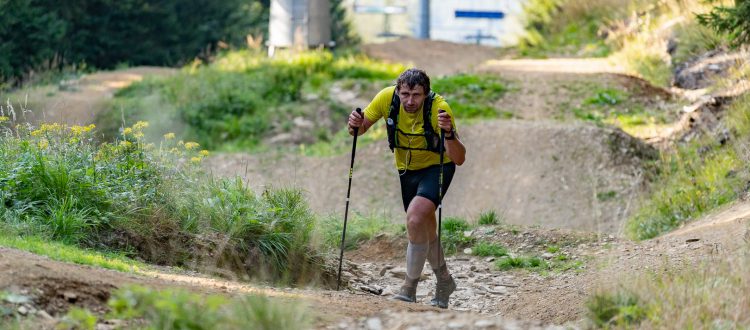An Everesting… or two
“What the hell is Everesting. You must a be a really crazy person to ride the same hill so many times. We’ll make it on Dlouhé Stráně, 10-11 times will do” we agreed with Dvořka and that’s how it actually started.
What is Everesting.
Everesting is a challenge, when you climb the height of Mt. Everest, 8848 m, by repeatedly climbing same hill. That says almost everything. Then there are the small details such as that to you have to complete the section there and back (so it can’t be a loop), it is always necessary to complete the whole section (you can’t later think about going up half the hill) and any break can’t be longer than two hours. At first glance, it looks stupid enough.
How I found out about it
That’s exactly what I thought when I first heard about Everesting – in July 2019 in an write up by Honza Bartas (who is therefore responsible for everything that follows). 20 ascends to Špindlerův Mlýn in his case sounded like a real stupidity.
“He must have gone bananas.” I said
“That’s probably because he has twins at home, so he prefers to do this kind of shit.” Dvořka replied.
“If we climb Dlouhé Stráně, only 10-11 times will be enough” we agreed and that’s how it actually started. Me, Dvořka, bike and Dlouhé Stráně. 10 times is not that many. That sounds like a good fun.
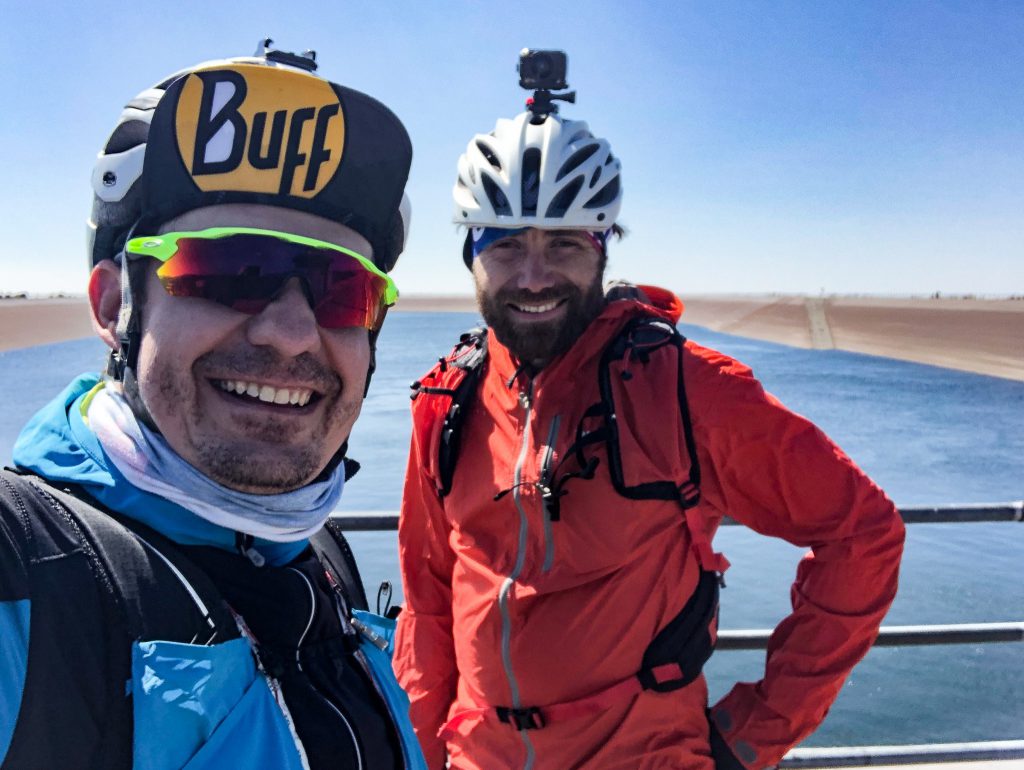
From idea to implementation the path is often not that straightforward. So it took us a year to get it done. A lot has changed since the original idea. The rules of Everesting themselves have changed – it is no longer possible to drive a loop, we had to modify (shorten) the route and we got to 15 climbs.
During the summer, Honza was plagued by a series of injuries, so he was promoted to the role of support, photographer, driver and media clown TrailRun.cz in one person, Jindra Sadílek from Runsport also joined this event. He can make excellent pot noodles and has a lighter. During summer I mentioned this craziness to Peggy Marvanová, and it was immediately clear that I wouldn’t be riding alone.
A week before the event itself, we sorted out the details (= “we started arranging things”) and wondered how we spice it up a bit more. We got to the idea to climb Everest twice – now on a road bike and sometime later on foot. And then it happened.
“So we’ll do it in one go. Straight away.” I suggested over the phone. As soon as I told it, I realized what a crazy idea it was, but the idea was born. We were making fun of Honza Bartas, that he went bananas because of his twins. And now we would do the same things twice and no twins were needed for that. Well, after all, I have nothing to do on Tuesday as well. Only the climb to Dlouhé Stráně remained from the original idea.
So, on foot I climb the ski slope in Kouty nad Desnou under the cable car rope 18 times and immediately after that I switch to a road bike and climb 15 times from the lower reservoir of Dlouhé Dlouhé Stráně pump storage power plant to its upper reservoir. Peggy would ride with me the cycling part. So not one Everesting, but three Everestings right away.
Everesting – take One.
On the morning of September 21st we were on our marks in Kouty nad Desnou. Honza Maťátko joined us as well, he made us a great coffee, Honza waved me off ceremoniously and I started to eat those vertical meters. The weather was nice, beautiful Indian summer, a lot of people came to support me, some told me in advance, while others just showed up (what a nice surprise!), so on more than 10 repeats (out of 18) I had some company, what more could I ask for?
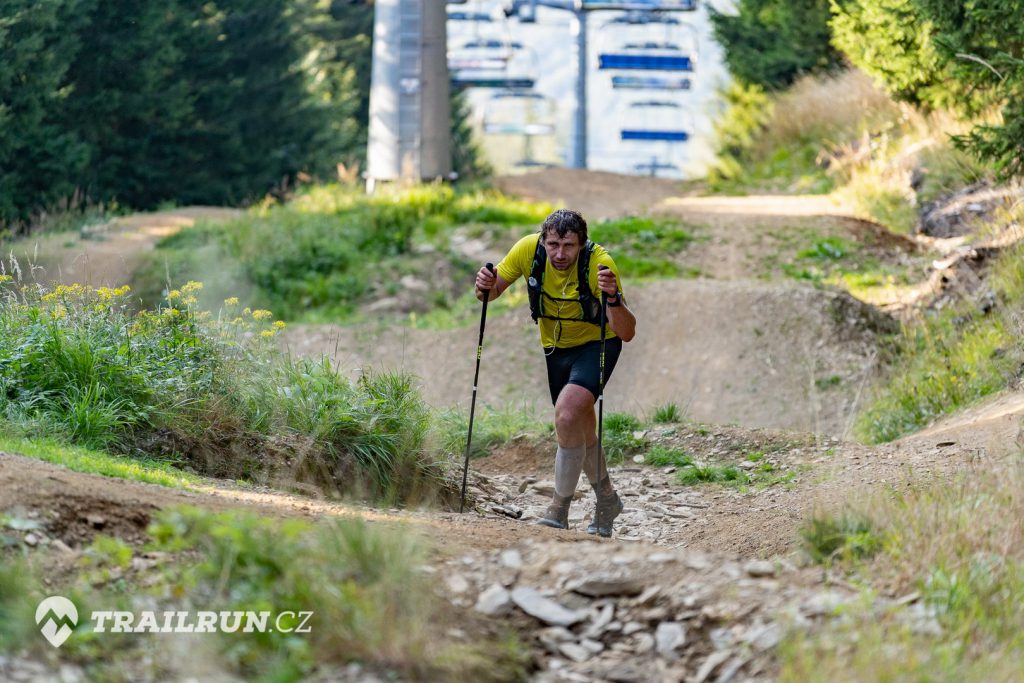
Half-life of a bear
After 19 hours and 34 minutes i completed the last climb and got back to Kouty, I was pretty desperate. I was shivering cold, my lower back was totally overloaded and will to fight dropped to 1938 France. Had not Peggy travelled all over the Czech Republic including a Czech Rail adventure, I would have reverted to original plan of two separate outings. But the team put me back on track, the boys cooked me something warm, Peggy somehow got my back working again and I got some sleep in a van. Two hours later (about 7 AM) happy to be finally sitting on my bike, Peggy and I started to eat first vertical meters of Dlouhé Stráně road.

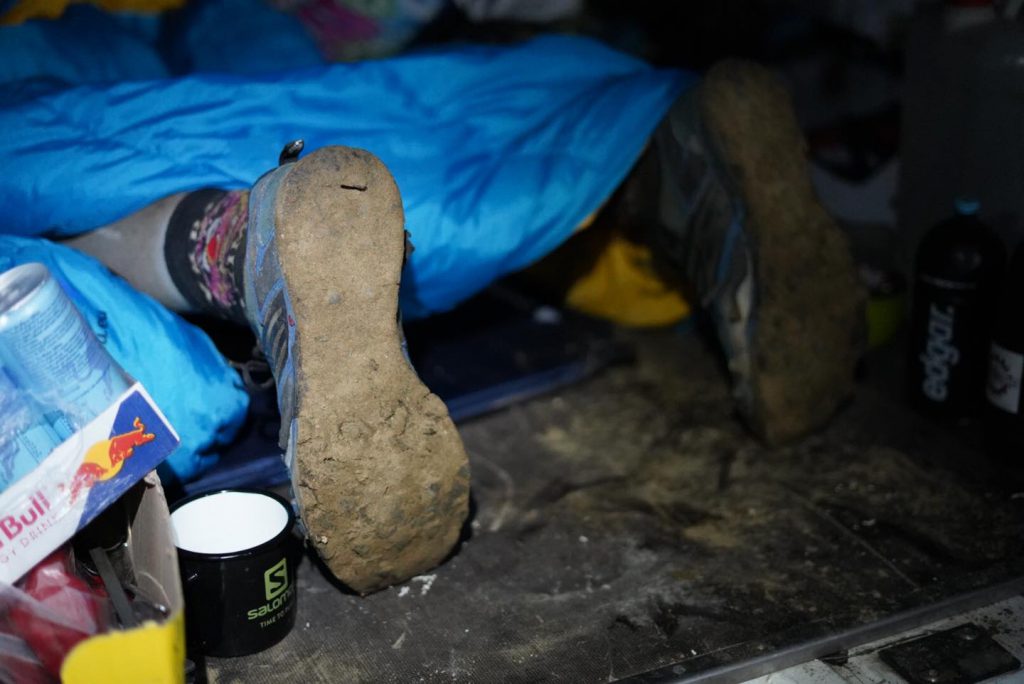
The joy lasted, pain came soon back – hotspots on my feet. It was all OK during the running/trekking part, I have not realized (stupid me!) that bike shoes are not breathable.
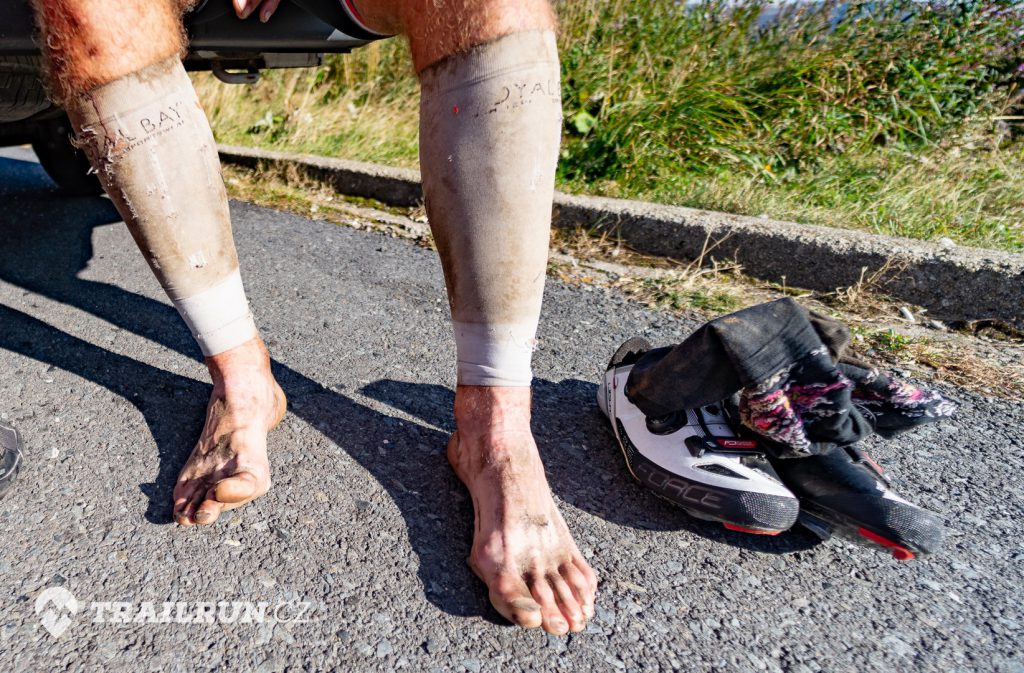
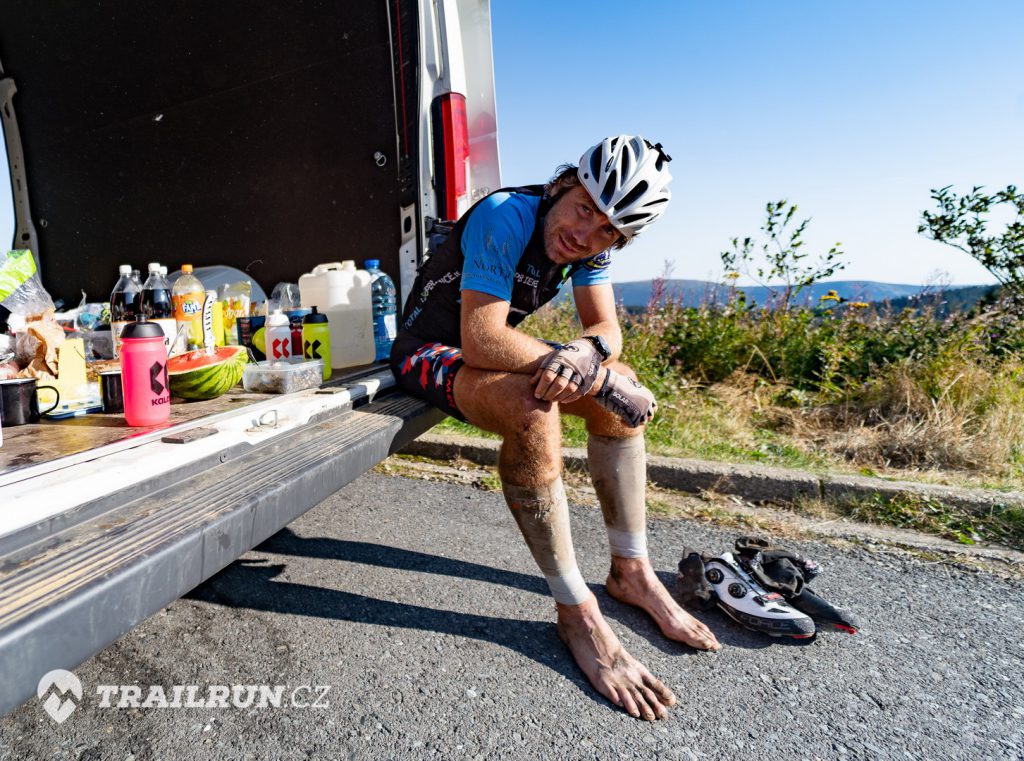
K.O. in the fifth round
We were in a good mood, going down for the fifth time from the upper reservoir, Peggy was already planning another Everesting at Praděd (WTF!?), when it happened. There were some works ahead marked by a plastic tape. As were passing by, some of those tapes were too loose and a wind gust tangled it to Peggy’s handlebars. She went over the them and it was over. Her helmet absorbed the hit, but her little finger was not that lucky. We immediately drove her to Šumperk hospital, and it was there, where our attempt for double Everesting ended. So the totals were:
Me: 9000 m on foot + 3000m on a road bike
Peggy: 1000m on foot + 3000m on a road bike + 1 bike fall
We knew only one thing – we want to finish it and we want to do it as soon as possible, the weather will get get worse.
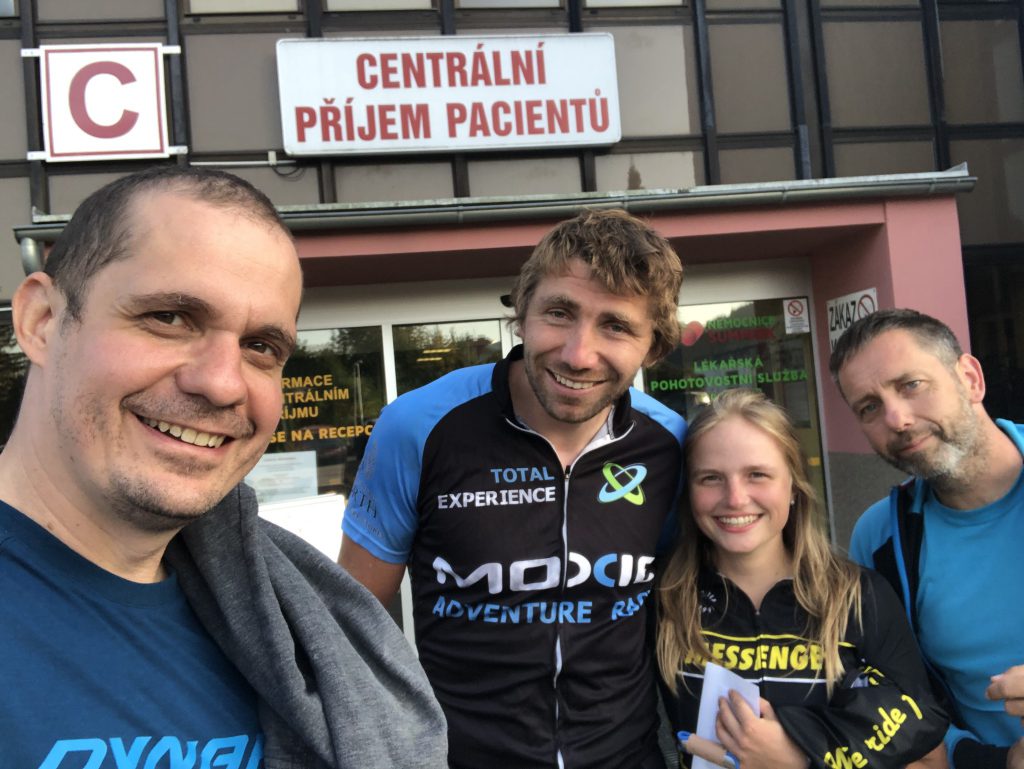
Everesting – take two
The 1st and 2nd attempt were only 15 days apart (with a running trip to Chamonix in the meantime), but the conditions could not be much more different – in the morning we were welcomed by a typical local autumn weather – cold, wind, fog and rain. During the first attempt we met a lot of people, we met no one today. Still, it could have be much worse – snow came few days later.
I was feeling fresh, we went quite well and steadily, yet we rode all the attempts up faster than last time. On the descent we rode much slower as the road was wet. On the down we always cooled down, so it was important to shield from the wind.
Our team and the overall setting remained the same. After 20 hours and 52 minutes, 310 km and 9,300 meters, we got off our bikes.
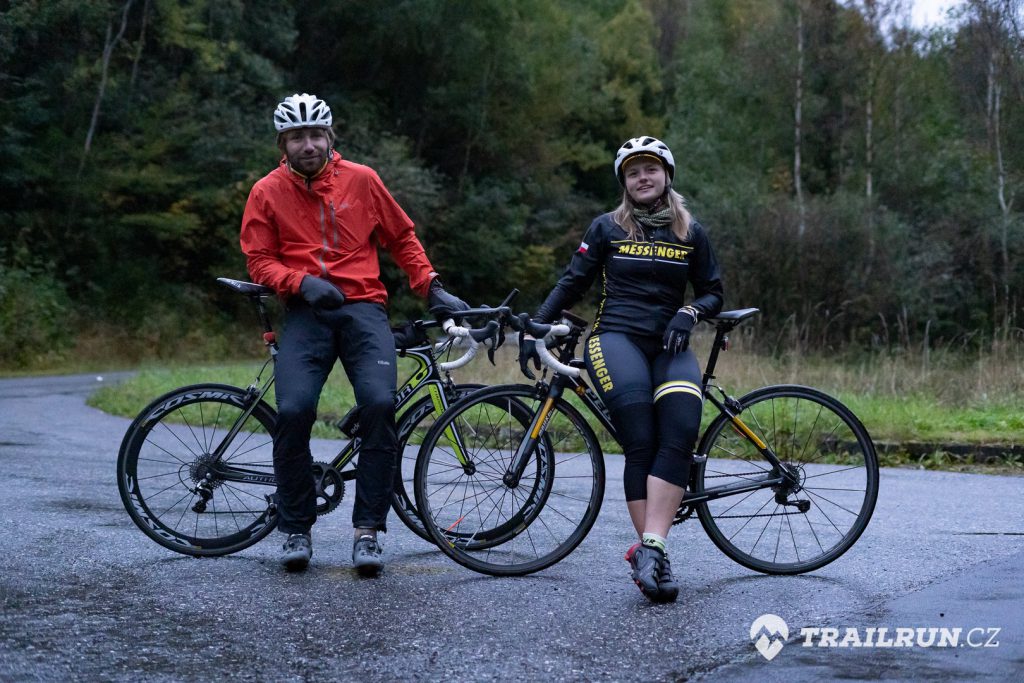
Easy before the start. 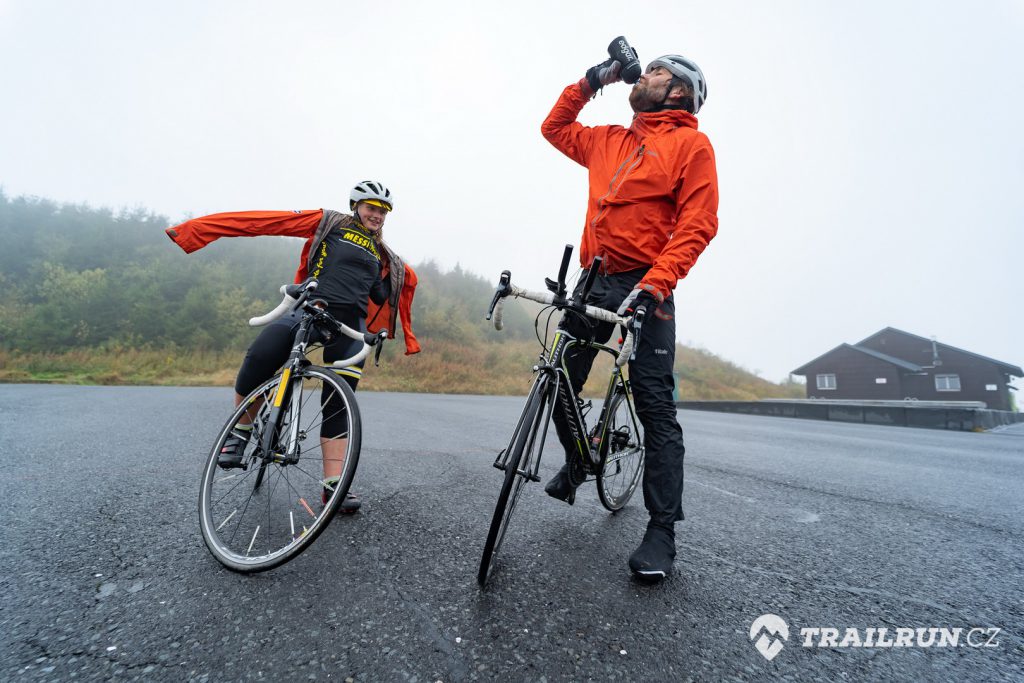
Regular procedure of changing in the fog 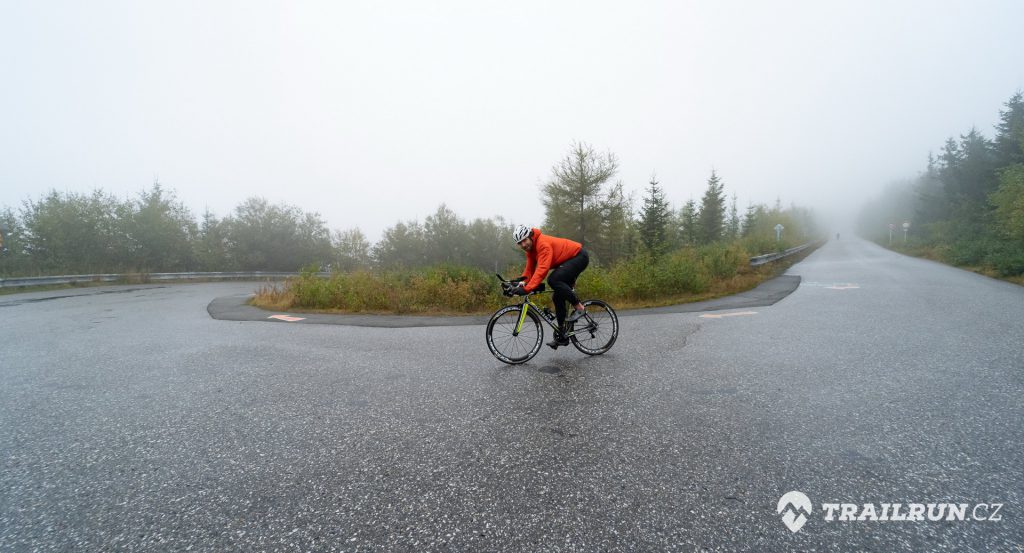
No one is happy with a wet road on a downhill.
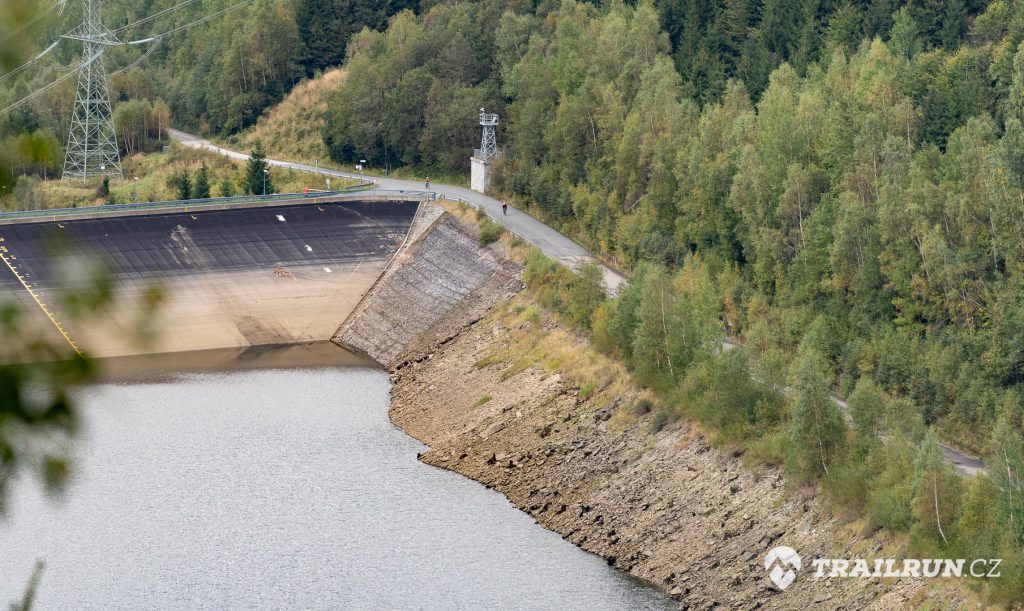
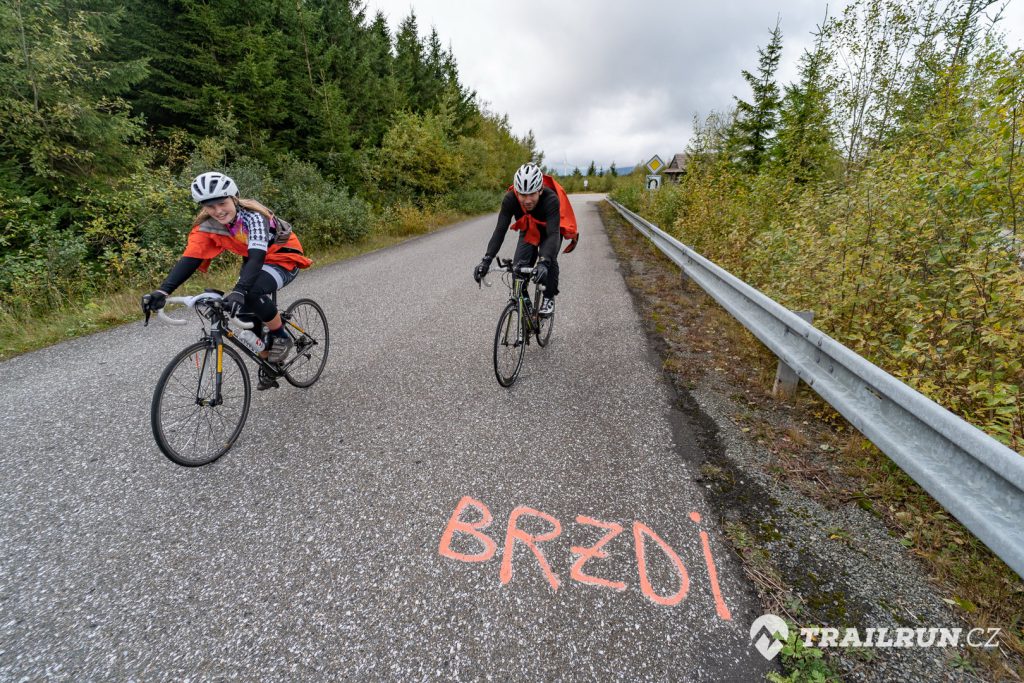
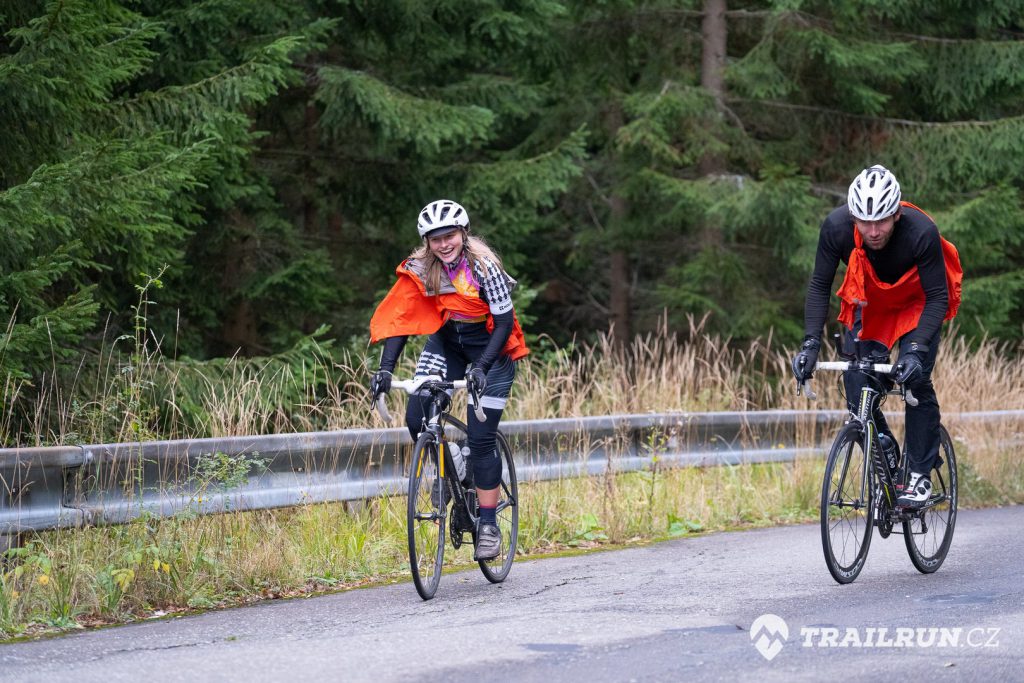
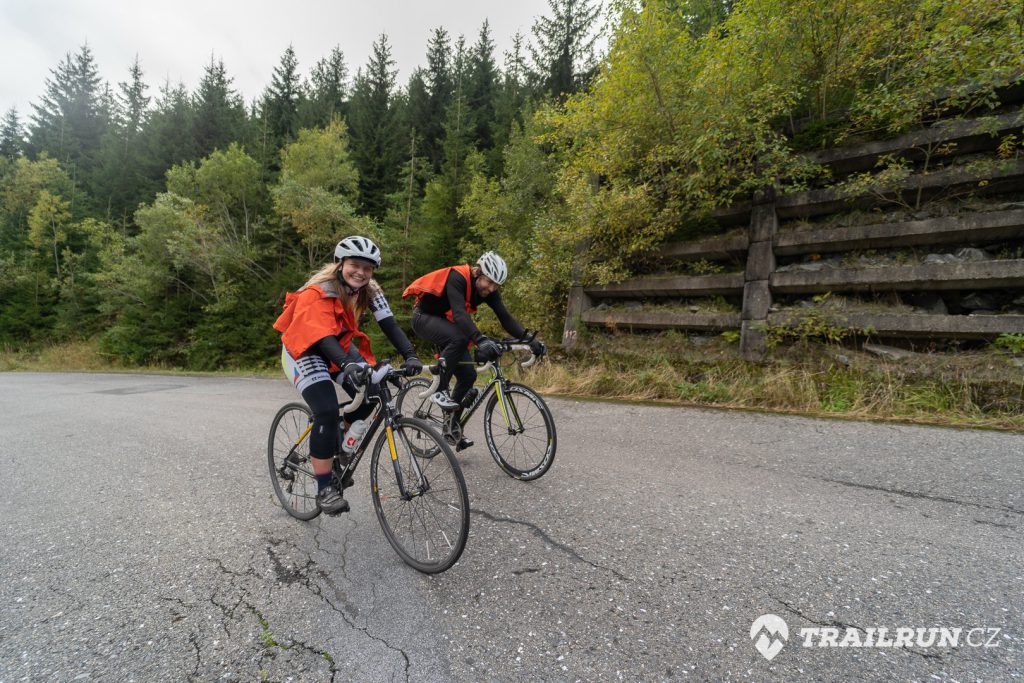
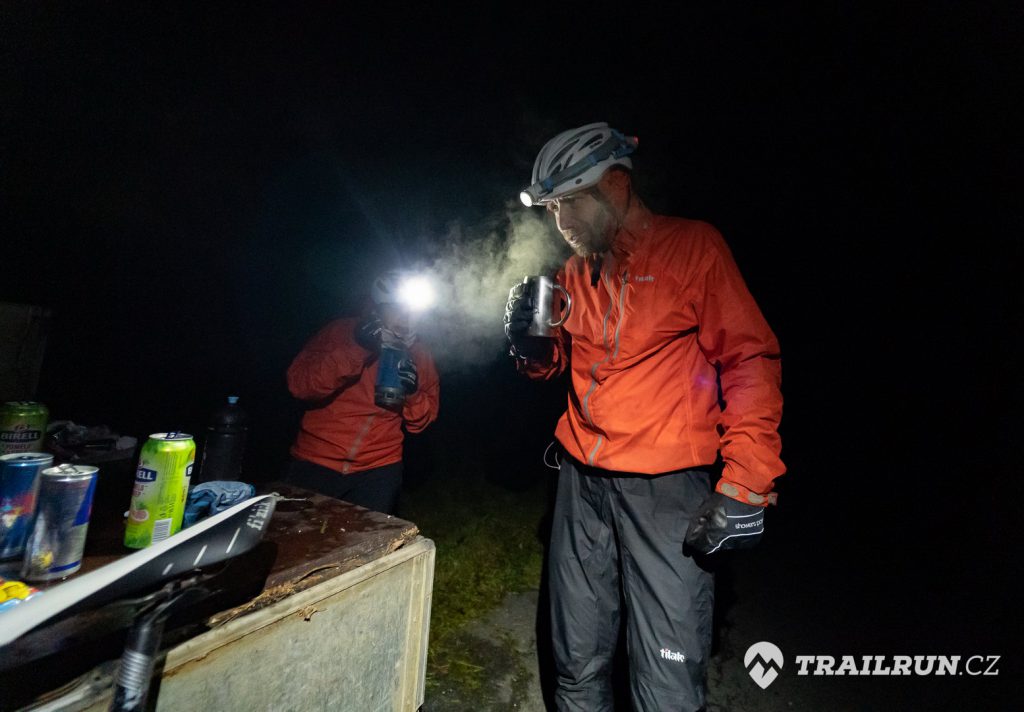
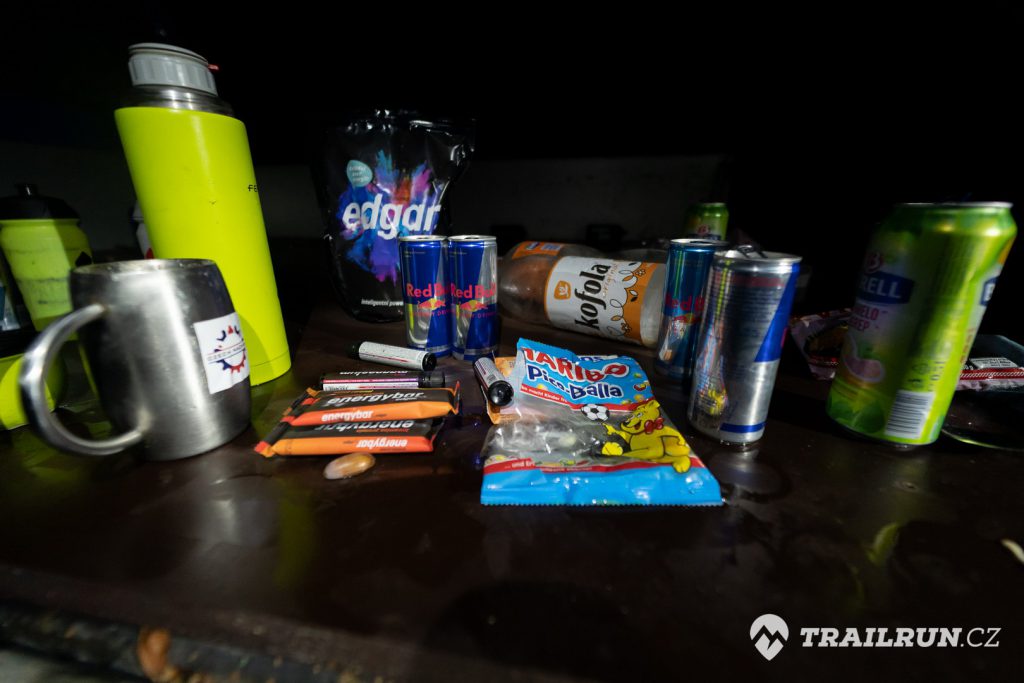
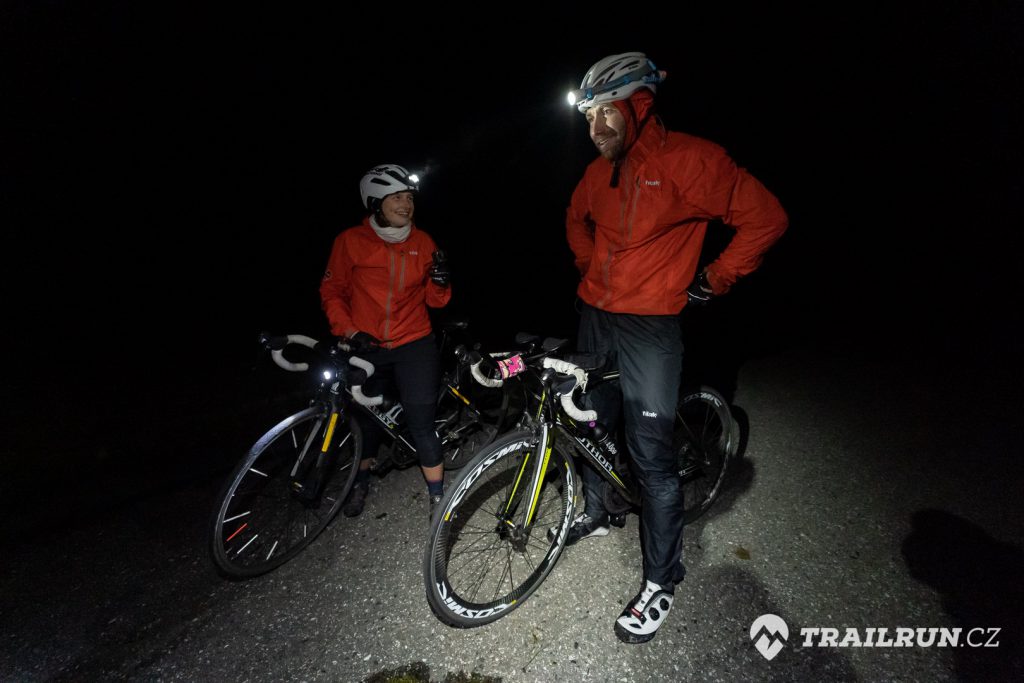
Totals:
(If you don’t like numbers, maths or graphs, you’d better skip this part. And take the effort to understand the exponential growth/decline.)
Below are three graphs: (1) climbing times on foot, (2) descend times on foot, and (3) climbing times on a road bike. The points are ordered chronologically.

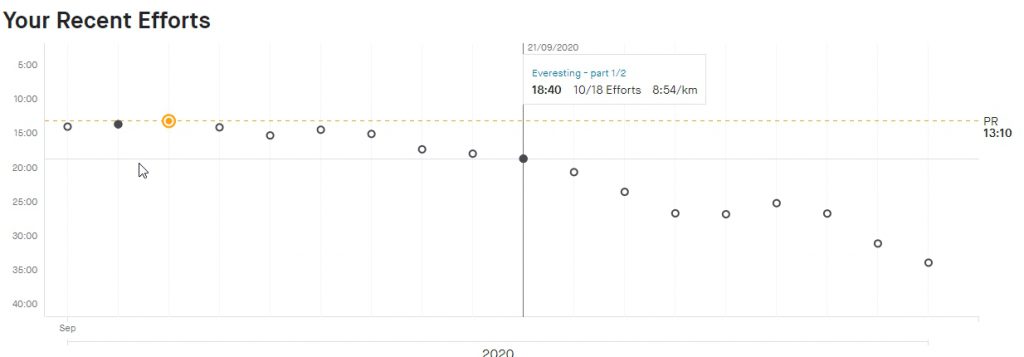
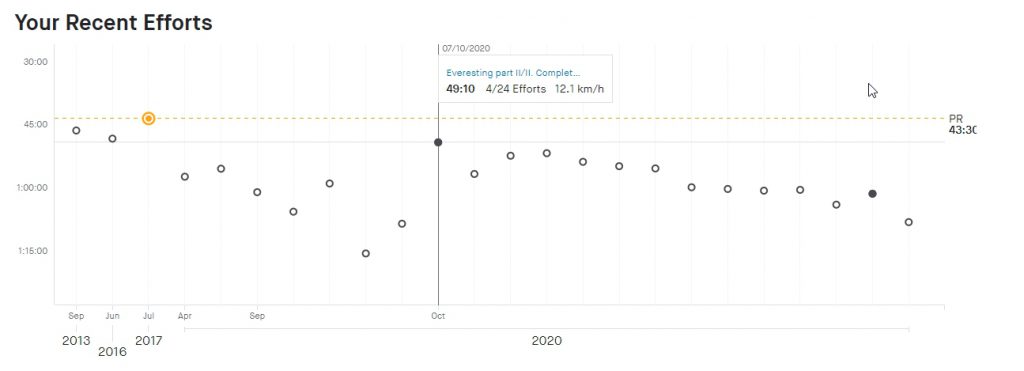
(1) Climb times on foot: The fastest climb took just under 30 minutes, while the slowest lasted over an hour. That’s double the time! If we disregard the three significantly slowest climbs, it is still 30 vs. 45 min – a slowing down by 50 percent. That’s awfully much and many times more than on the cycling part. What makes the difference? I see two reasons here:
- I started with much higher effort on foot than on a bike, so the gradual natural deceleration is more pronounced.
- Overall increasing fatigue is not the only factor. On the foot part, some effects were not present at the beginning and showed only after some time. Except for fatigue, muscles shorten, so they have shorter working range (e.g. your stride is shorter). Some muscle groups got overloaded – especially the abdomen and lower back. This could be felt in the last 6 ascents (and descents). So I was very stiff and careful (= slowed down) and in a few cases, I took a shorter or longer breaks on the way up – the three slowest laps are results of these pauses.
If we take into account only moving time, these pauses disappear. Apart from gradual deceleration, there are also “drops” or “steps” in the graph. These are exactly the moments when a new factor manifested itself and there was a sharp drop in speed.
(2) Descent times (running): Take a note of a few facts.
- The fastest run is not the first run, but the third one – I learned the route, found and became more efficient – I found out where I could send it and where I had be more careful.
- I kept up the pace until the 10th run, then I started to fade as my hips started to be overloaded.
- The relative deceleration is even greater than on the way up (and I didn’t take any major breaks). This is certainly not due to fatigue, but rather because of overload of some muscles and rapid drop in movement efficiency.
(3) Ascend times (cycling): This is the most interesting of all three graphs, as it contains both data from the first attempt (to the left of the marked point in the graph) and from the second attempt (right).
- 11 of the 15 climbs were between 52 and 60 minutes. First one is faster as Peggy started with a kick, for second climb we were accompanied by our friend, so we slowed down. The penultimate climb is slow as well, as we were so cold at the foot of the ascend, that we didn’t eat anything, but took it with us and were eating it along the way up. The last climb (not in the graph) we did in 56 min.
In short, we haven’t started hard from the beginning, so we have not slowed down that much. It was simply a great day at Dlouhé Stráně. Also there are no dramatic speed drops as in the case of climbs on foot. Five points in the graph representing the climbs in the first attempt only illustrate how I was doing after finishing Everesting on foot: I started at the same pace as I finished the second time. And I was slowing down rapidly.
Before the second attempt, I got pedals with a wattmeter. They were new, I didn’t have much data, so I would try to analyze what I had. 273W on the first climb, the rest was between 210 and 250W. These are pretty usual numbers, I guess. The first finding is that power calculated by Strava is slightly lower than measured values.
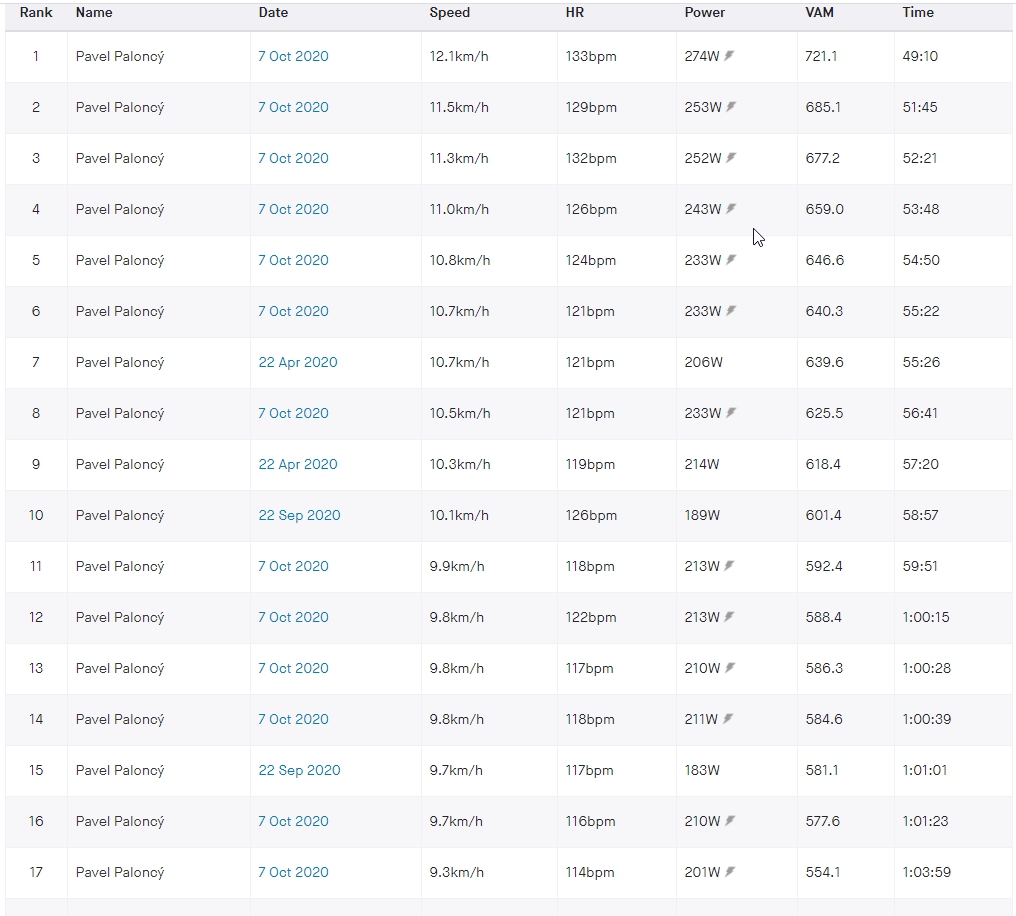
Lessons learned:
Bad slope choice. Choosing the right course is crucial. This ascend looked good – almost straight line, 500m over 2.2 km, a slope of 23 percent. So where was the problem? Every year, a race runs up this route – the trail is blazed, the bushes and blueberry thorny bushes are cut. Not this year due to covid. September is not June, and the trail was overgrown. Like a jungle. There were several fallen trees and logs in the steepest section. I could hardly see the ground beneath my feet – the path was stony and rough. I had to go a lot slower, running down this hill cost me a lot of effort and in the end it hit me hard. The only positive thing on this choice is that it was perfect training for the Barkley Marathons.

Extreme load. Almost 9000m up (and especially down) meters is a lot. To catch your breath is not a problem, my cardio system was working great. But several muscles suffer from extreme load. On the ascent, calf muscles do all the work, while on descend quadriceps get thrashed. If you use trekking poles and the terrain is steep (so it makes sense to use them) you are using your abdominal muscles, or at least you should. I rely on them with a force of a bear, so the result came shortly – the abdominal muscles got overloaded and were unable to take the load anymore, so the lower back took over the job and got overloaded soon afterwards. Due to this reason, for the last few laps I suffered a lot, it was sheer will power that carried me all the way and down. My thoughts were all over the place. It was my team and experience that got me through.
You are not on the finish line until you are on the finish line. Even if you go carefully, slow down, or keep it “under control,” there is still nothing for granted. All it takes is one wrong step, a fall, a loss of concentration and focus, a twist, muscle strain or cramps and it’s over. I had these thoughts just after completing the running part. It turned out to be the case few hours later.
Playlist. What saves you when no one is going up or down with you? FOr me, it is usually music (and food!) so good playlist (and menu!) is essential. Positive Pearl Jam, Pixies if you want some punk, Neil Young if simply like great musid, Pink Floyd, Roger Waters and I could go one. It’s up to your taste, but do your homework and prepare a large library.
Sleep + second night. Peggy had a crash, so we quit the attempt. That is the short version. The second night was slowly looming, and it was more than clear that the attempt would extend long into the next night. In the night there is always a risk of falling asleep, and second night poses significant risk, especially when going down. Here the descent was 15 minutes in one stretch, where you got to 60 km/h after few seconds. This sounds like potential problem. In the second attempt, this was not even hint of such a risk.
What’s next?
Everesting is a nice thing, but it was definitely enough for me now and I’ll start with something else. Or something more? What it will it be? Who knows. But if I just look at the team that orchestrated this, there will be no shortage of more funny stuff. If you are intested in my next adventures, follow me on Facebook and Instagram.
// If you haven’t noticed, photos are courtesy of Honza Dvořáček Trailrun.cz. You can see videos at Trailrun Facebook.

